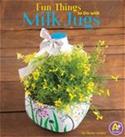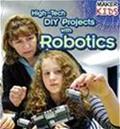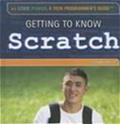It’s time to let off some STEAM! If the weather is keeping your students inside, why not check out these excellent new series and titles that introduce students of all ages to Science, Technology, Engineering, Arts, and Math topics through plenty of hands-on projects. Reading books that encourage learners of all ages to engage in hands-on, minds-on learning is a perfect springboard to having students write “how-to” texts of their own.
Ages 4–8
Lawrence, Ellen. (2015). Liquids and Solids (Science Slam: Fun-Damental Experiments). New York, NY: Bearport Publishing Company.
 It’s never too early to introduce young children to the amazing world of science. Building interest in STEM-focused careers starts with our earliest learners! This book is the latest in the Bearport Science Slam series and is an excellent read-aloud with plenty of mini-science experiments to try on every page. Something this series does especially well is introduce young scientists to the idea of keeping a science notebook. Writing prompts are included throughout the book to instruct readers when to record, sketch, and jot in their journal. Each book in the series provides additional resources including books as well as a publisher-sponsored website to learn more about the topic.
It’s never too early to introduce young children to the amazing world of science. Building interest in STEM-focused careers starts with our earliest learners! This book is the latest in the Bearport Science Slam series and is an excellent read-aloud with plenty of mini-science experiments to try on every page. Something this series does especially well is introduce young scientists to the idea of keeping a science notebook. Writing prompts are included throughout the book to instruct readers when to record, sketch, and jot in their journal. Each book in the series provides additional resources including books as well as a publisher-sponsored website to learn more about the topic.
Ventura, Marne. (2015). Fun Things to Do With Milk Jugs. North Mankato, MN: Capstone Press.
 Start planting the seeds of a sustainable future by introducing young children to craft projects that upcycle trash into treasures! An excellent new series to check out is the Fun Things to Do with… collection. This book has easy-to-follow directions and clear photographs showing young readers how to create a bird feeder, mini garden, games, and more out of plastic drink jugs. Other books in the series follow a similar format with egg cartons, cardboard tubes, paper plates, and cups.
Start planting the seeds of a sustainable future by introducing young children to craft projects that upcycle trash into treasures! An excellent new series to check out is the Fun Things to Do with… collection. This book has easy-to-follow directions and clear photographs showing young readers how to create a bird feeder, mini garden, games, and more out of plastic drink jugs. Other books in the series follow a similar format with egg cartons, cardboard tubes, paper plates, and cups.
Ages 9–11
Hewitt, Sally. (2014). Hands-On! Art Projects. Nashville, TN: Flowerpot Press.
 This beautiful paperback book is designed to introduce young artists to great masters and encourage them to use art as a new kind of mentor text. Organized into five subject-based chapters, this comprehensive text is packed with projects that show the reader how to sketch like Leonardo, see the world like Dali, and paint like Monet, to name just a few. Written by an elementary art teacher, this book introduces children to the language and literacy of art.
This beautiful paperback book is designed to introduce young artists to great masters and encourage them to use art as a new kind of mentor text. Organized into five subject-based chapters, this comprehensive text is packed with projects that show the reader how to sketch like Leonardo, see the world like Dali, and paint like Monet, to name just a few. Written by an elementary art teacher, this book introduces children to the language and literacy of art.
Hildyard, Anne; Rupert Matthews; James Mitchem; Sue Unstead (Eds.) (2014). Children’s Book of Magic. New York, NY: DK Publishing.
 Great magicians know how to use their hands to distract and create illusions for their audiences. This beautiful, oversized book published by DK includes easy-to-follow directions and large, clear photographs for performing some basic tricks, as well as plenty of “insider tips” all budding magicians should know in order to hone their craft. In typical DK style, this book is meant to be a dual reading and viewing experience.
Great magicians know how to use their hands to distract and create illusions for their audiences. This beautiful, oversized book published by DK includes easy-to-follow directions and large, clear photographs for performing some basic tricks, as well as plenty of “insider tips” all budding magicians should know in order to hone their craft. In typical DK style, this book is meant to be a dual reading and viewing experience.
Ages 12–14
Claybourne, Anna. (2015). Make it Glow. Chicago, IL: Raintree Press.
 In the Whiz Kid Science series, author Anna Claybourne introduces young scientists to a variety of scientific concepts. In Make it Glow, Claybourne focuses on the science of light to show readers how things like glow-in-the-dark stickers work, and then encourages them to create their own light-based science projects. Well-structured directions and clearly drawn diagrams guide young readers through the various experiments in the book. Other books in the series focus on different topics like the science of sound, liquids, color, and more.
In the Whiz Kid Science series, author Anna Claybourne introduces young scientists to a variety of scientific concepts. In Make it Glow, Claybourne focuses on the science of light to show readers how things like glow-in-the-dark stickers work, and then encourages them to create their own light-based science projects. Well-structured directions and clearly drawn diagrams guide young readers through the various experiments in the book. Other books in the series focus on different topics like the science of sound, liquids, color, and more.
Murphy, Maggie. (2015). High-Tech DIY Projects With Robotics. NY: Rosen Publishing Group.
Anyone familiar with the Maker Movement will appreciate this new series called Maker Kids in which young inventors are introduced to high-tech projects that  involve electronics, microcontrollers, 3-D printing, and more. In this book focused on robotics, Murphy explains robotics in a kid-friendly way that doesn’t shy away from high-tech vocabulary, and then walks readers through their very own robot-building projects. These books would work well for an after-school engineering club for elementary students.
involve electronics, microcontrollers, 3-D printing, and more. In this book focused on robotics, Murphy explains robotics in a kid-friendly way that doesn’t shy away from high-tech vocabulary, and then walks readers through their very own robot-building projects. These books would work well for an after-school engineering club for elementary students.
Ages 15+
Kuskowski, Alex. (2015). Cool Knitting for Kids. Minneapolis, MN: Abdo Publishing.
 Teens are crafty, too! Knitting and other “retro” crafts are making a comeback with kids of all ages. This book offers beginners an easy-to-follow introduction to knitting. Teens could also use this small book filled with close-up photographs to teach younger children how to get started with knitting. Also included are directions for dyeing your own yarn as well as some basic projects like knitting a scarf and a small purse.
Teens are crafty, too! Knitting and other “retro” crafts are making a comeback with kids of all ages. This book offers beginners an easy-to-follow introduction to knitting. Teens could also use this small book filled with close-up photographs to teach younger children how to get started with knitting. Also included are directions for dyeing your own yarn as well as some basic projects like knitting a scarf and a small purse.
Nagle, Jeanne. (2015). Getting to Know Scratch. New York, NY: Rosen Central.
A popular initiative in schools is Hour of Code. Designed to give students of all ages an opportunity to learn how computer coding works, this event drew more  than 15 million users in one week!
than 15 million users in one week!
Pair your coding lessons with the Code Power: A Teen Programmer’s Guide series. This book tells the story behind Scratch, one of the many “languages” in the computer coding world. Written to familiarize students with the vocabulary of coding in Scratch, this book provides an interesting history of the programming code as well as real-life examples of other teens actively using the code to design computer programs. Other books in this series introduce students to additional coding programs including Alice, Hackety Hack, and Python, among others.
Jennifer W. Shettel is an associate professor at Millersville University in Pennsylvania, where she teaches undergraduate and graduate courses in literacy for preservice and practicing teachers. Prior to joining the faculty at Millersville, she spent 16 years as an elementary classroom teacher and reading specialist. These reviews are submitted by members of the International Literacy Association's Children's Literature and Reading Special Interest Group (CL/R SIG)and are published weekly on Literacy Daily.